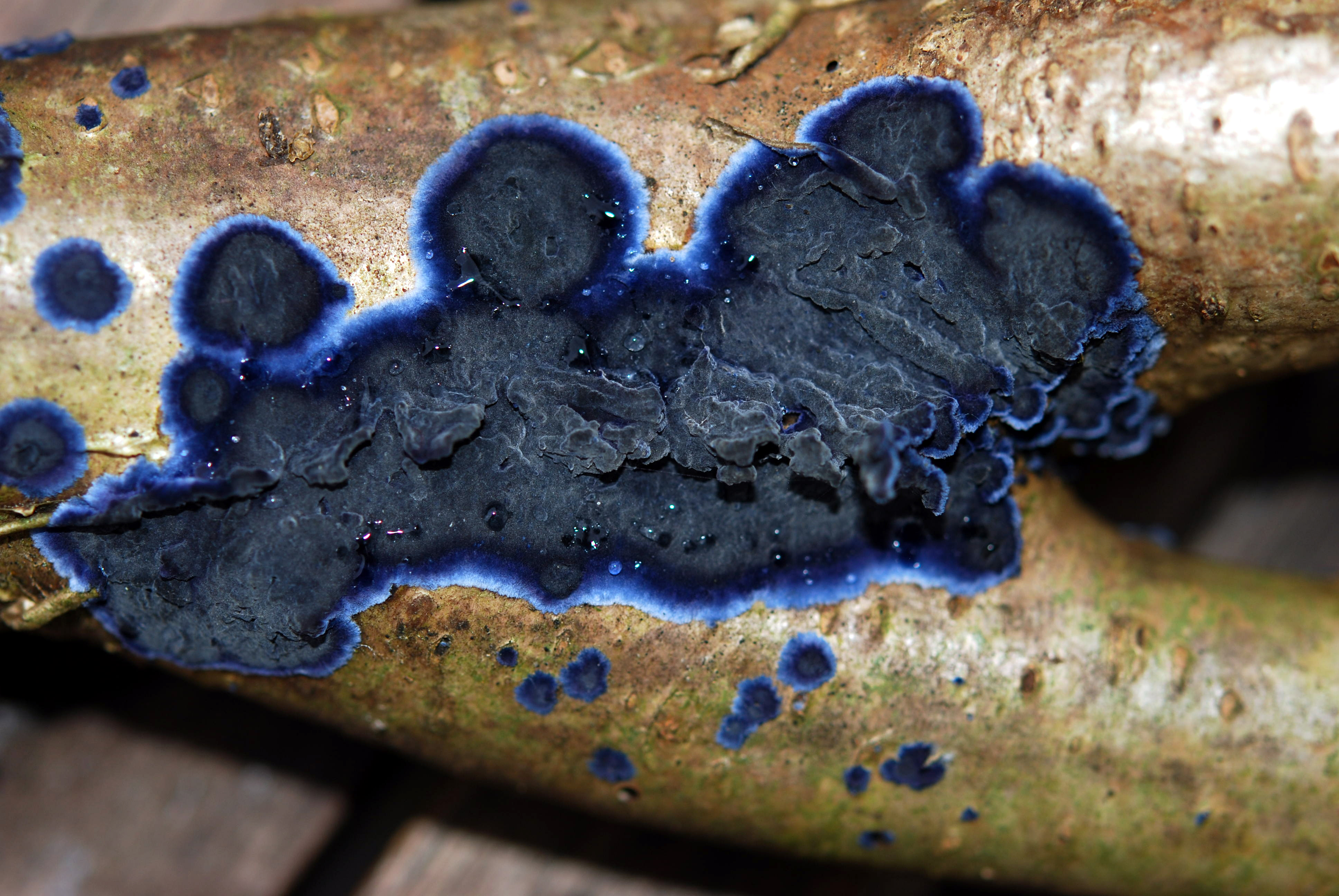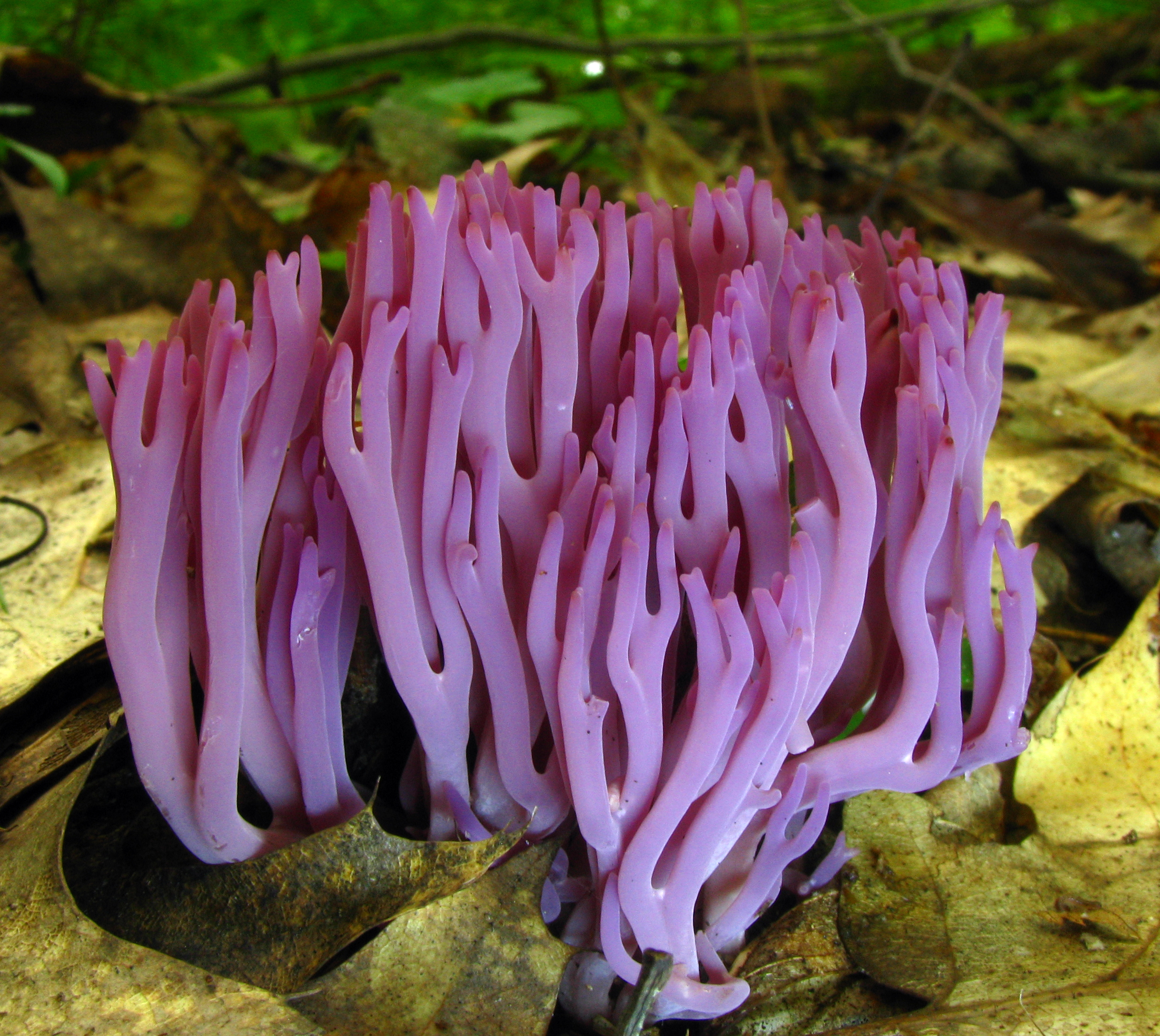|
Dacrymycetales
The Dacrymycetes are a class of fungi in the Basidiomycota. The class currently contains the single order Dacrymycetales, with a second proposed order Unilacrymales now treated at the family level. The order contains four families and has a cosmopolitan distribution. All fungi in the Dacrymycetes are wood-rotting saprotrophs. Basidiocarps (fruit bodies) are ceraceous to gelatinous, typically yellow to orange as a result of carotenoid Carotenoids () are yellow, orange, and red organic pigments that are produced by plants and algae, as well as several bacteria, archaea, and fungi. Carotenoids give the characteristic color to pumpkins, carrots, parsnips, corn, tomatoes, cana ... pigments, and variously corticioid (effused and patch-forming), disc- or cushion-shaped, spathulate, or clavarioid (club or coral-like). Microscopically, nearly all species have distinctive Y-shaped holobasidia. Species were formerly placed in the Heterobasidiomycetes and are informally included ... [...More Info...] [...Related Items...] OR: [Wikipedia] [Google] [Baidu] |
Dacrymycetes
The Dacrymycetes are a class of fungi in the Basidiomycota. The class currently contains the single order Dacrymycetales, with a second proposed order Unilacrymales now treated at the family level. The order contains four families and has a cosmopolitan distribution. All fungi in the Dacrymycetes are wood-rotting saprotrophs. Basidiocarps (fruit bodies) are ceraceous to gelatinous, typically yellow to orange as a result of carotenoid Carotenoids () are yellow, orange, and red organic pigments that are produced by plants and algae, as well as several bacteria, archaea, and fungi. Carotenoids give the characteristic color to pumpkins, carrots, parsnips, corn, tomatoes, cana ... pigments, and variously corticioid (effused and patch-forming), disc- or cushion-shaped, spathulate, or clavarioid (club or coral-like). Microscopically, nearly all species have distinctive Y-shaped holobasidia. Species were formerly placed in the Heterobasidiomycetes and are informally include ... [...More Info...] [...Related Items...] OR: [Wikipedia] [Google] [Baidu] |
Unilacrymaceae
The Unilacrymaceae are a family (biology), family of fungi in the order (biology), order Dacrymycetales. The family currently contains the single genus ''Unilacryma'' with two known species from Europe, North Asia, and North America. The family was originally placed within its own order, the Unilacrymales, but subsequent research suggests it is better accommodated within the Dacrymycetales. As with other members of the Dacrymycetes, species within the ''Unilacrymaceae'' are saprotrophs, occur on dead wood, and have gelatinous basidiocarps. Microscopically all species have clamp connections, clamped hyphae, branched hyphidia, and muriform (multiseptate), subglobose to ellipsoid basidiospores. ''Unilacryma unispora'' is unique within the Dacrymycetes in having single-spored basidia. References Dacrymycetes, Basidiomycota families Taxa described in 2013 {{Agaricomycotina-stub ... [...More Info...] [...Related Items...] OR: [Wikipedia] [Google] [Baidu] |
Calocera Viscosa
''Calocera viscosa'' is a species of fungus in the family Dacrymycetaceae. In the United Kingdom, it has the recommended English name of yellow stagshorn. In North America it is variously called coral jelly fungus, jelly staghorn, yellow false coral, yellow tuning fork, and jelly antler. The basidiocarps (fruit bodies) are small, gelatinous, bright golden yellow, and branched. ''Calocera viscosa'' grows on logs and dead wood of conifers. It is a common species throughout Europe and has also been recorded from North America, Asia, and Australia. Taxonomy The species was originally described as ''Clavaria aurea'' by the German naturalist and explorer Alexander von Humboldt in 1793, but the name is illegitimate since it had already been used for a different species. The species was legitimately described as ''Clavaria viscosa'' from Germany in 1794 by South African-born mycologist Christiaan Hendrik Persoon. It was transferred to the genus '' Calocera'' by Swedish mycologist Eli ... [...More Info...] [...Related Items...] OR: [Wikipedia] [Google] [Baidu] |
Cerinomycetaceae
The Cerinomycetaceae are a family of fungi in the order Dacrymycetales. The family currently contains the single genus '' Cerinomyces'' which has a cosmopolitan distribution. Species within the ''Cerinomycetaceae'' are saprotrophs and occur on dead wood. As originally conceived, the family comprised all species of the Dacrymycetes having effused, corticioid basidiocarps (fruit bodies). Molecular research, based on cladistic analysis of DNA sequences, has however shown that this circumscription is not valid. As a result, the family now contains some (but not all) species having corticioid basidiocarps and some species (previously referred to the Dacrymycetaceae The Dacrymycetaceae are a family of fungi in the order Dacrymycetales. Species are saprotrophs and occur on dead wood. Their distribution is worldwide. Basidiocarps (fruit bodies) are ceraceous (waxy) to gelatinous, often yellow to orange, and va ...) with gelatinous, pustular basidiocarps. References Basidiomyc ... [...More Info...] [...Related Items...] OR: [Wikipedia] [Google] [Baidu] |
Dacrymycetaceae
The Dacrymycetaceae are a family of fungi in the order Dacrymycetales. Species are saprotrophs and occur on dead wood. Their distribution is worldwide. Basidiocarps (fruit bodies) are ceraceous (waxy) to gelatinous, often yellow to orange, and variously clavarioid, disc-shaped, cushion-shaped, spathulate (spoon-shaped), or corticioid (effused). Genera in the Dacrymycetaceae have traditionally been differentiated on basidiocarp morphology, in later years following the monographs of New Zealand mycologist Robert McNabb. Molecular research, based on cladistic analysis of DNA sequences, has however shown that morphology is not a good indicator of natural relationships. To date, only the recently described genus '' Dendrodacrys'' is monophyletic In biological cladistics for the classification of organisms, monophyly is the condition of a taxonomic grouping being a clade – that is, a grouping of organisms which meets these criteria: # the grouping contains its own most rece ... [...More Info...] [...Related Items...] OR: [Wikipedia] [Google] [Baidu] |
Dacryonaemataceae
The Dacryonaemataceae are a family of fungi in the order Dacrymycetales. The family currently contains the single genus ''Dacryonaema Dacryonaema is a genus of fungi in the order Dacrymycetales. As with other members of the Dacrymycetes, species of ''Dacryonaema'' are saprotrophs, occur on dead wood, and have gelatinous basidiocarps. Microscopically all species have clamped h ...'' with three known species from Europe and North America. References Basidiomycota families {{Agaricomycotina-stub ... [...More Info...] [...Related Items...] OR: [Wikipedia] [Google] [Baidu] |
Heterobasidiomycetes
Heterobasidiomycetes, including jelly fungi, smuts and rusts, are basidiomycetes with septate basidia. This contrasts them to homobasidiomycetes (alternatively called holobasidiomycetes), including most mushrooms and other Agaricomycetes, which have aseptate basidia. The division of all basidiomycetes between these two groups has been influential in fungal taxonomy, and is still used informally, but it is no longer the basis of formal classification. In modern taxonomy homobasidiomycetes roughly correspond to the monophyletic class Agaricomycetes, whereas heterobasidiomycetes are paraphyletic and as such correspond to various taxa from different taxonomic ranks, including the Basidiomycota other than Agaricomycetes and a few basal groups within Agaricomycetes. Distinction between homo- and heterobasidiomycetes In addition to having septate basidia, heterobasidiomycetes also frequently possess large irregularly shaped sterigmata and spores that are capable of self-replication ... [...More Info...] [...Related Items...] OR: [Wikipedia] [Google] [Baidu] |
Corticioid
The corticioid fungi are a group of fungi in the Basidiomycota typically having effused, smooth basidiocarps (fruit bodies) that are formed on the undersides of dead tree trunks or branches. They are sometimes colloquially called crust fungi or patch fungi. Originally such fungi were referred to the genus '' Corticium'' ("corticioid" means ''Corticium''-like) and subsequently to the family '' Corticiaceae'', but it is now known that all corticioid species are not necessarily closely related. The fact that they look similar is an example of convergent evolution. Since they are often studied as a group, it is convenient to retain the informal (non-taxonomic) name of "corticioid fungi" and this term is frequently used in research papersLarsson K-H, Larsson E, Koljalg U. (2004). High phylogenetic diversity among corticioid homobasidiomycetes. ''Mycological Research'' 108: 983–1002. and other texts. History The genus ''Corticium'' was established by Persoon in 1794 for fungi having s ... [...More Info...] [...Related Items...] OR: [Wikipedia] [Google] [Baidu] |
Holobasidia
A basidium (: basidia) is a microscopic spore-producing structure found on the hymenophore of reproductive bodies of basidiomycete fungi. The presence of basidia is one of the main characteristic features of the group. These bodies are also called tertiary mycelia, which are highly coiled versions of secondary mycelia. A basidium usually bears four sexual spores called basidiospores. Occasionally the number may be two or even eight. Each reproductive spore is produced at the tip of a narrow prong or horn called a sterigma (), and is forcefully expelled at full growth. The word ''basidium'' literally means "little pedestal". This is the way the basidium supports the spores. However, some biologists suggest that the structure looks more like a club. A partially grown basidium is known as a basidiole. Structure Most basidiomycota have single celled basidia (holobasidia), but some have ones with many cells (a phragmobasidia). For instance, rust fungi in the order ''Puccinales'' h ... [...More Info...] [...Related Items...] OR: [Wikipedia] [Google] [Baidu] |
Clavarioid
The clavarioid fungi are a group of fungi in the Basidiomycota typically having erect, simple or branched basidiocarps (fruit bodies) that are formed on the ground, on decaying vegetation, or on dead wood. They are colloquially called club fungi and coral fungi. Originally such fungi were referred to the genus '' Clavaria'' ("clavarioid" means ''Clavaria''-like), but it is now known that clavarioid species are not all closely related. Since they are often studied as a group, it is convenient to retain the informal (non-taxonomic) name of "clavarioid fungi" and this term is frequently used in research papers. History ''Clavaria'' was one of the original genera created by Linnaeus in his ''Species Plantarum'' of 1753. It contained all species of fungi with erect, club-shaped or branched (coral-like) fruit bodies, including many that are now referred to the Ascomycota. Subsequent authors described over 1200 species in the genus. With increasing use of the microscope in the late ninet ... [...More Info...] [...Related Items...] OR: [Wikipedia] [Google] [Baidu] |
Spathulate
This glossary of botanical terms is a list of definitions of terms and concepts relevant to botany and plants in general. Terms of plant morphology are included here as well as at the more specific Glossary of plant morphology and Glossary of leaf morphology. For other related terms, see Glossary of phytopathology, Glossary of lichen terms, and List of Latin and Greek words commonly used in systematic names. A B ... [...More Info...] [...Related Items...] OR: [Wikipedia] [Google] [Baidu] |
Family (biology)
Family (, : ) is one of the eight major hierarchical taxonomic ranks in Linnaean taxonomy. It is classified between order and genus. A family may be divided into subfamilies, which are intermediate ranks between the ranks of family and genus. The official family names are Latin in origin; however, popular names are often used: for example, walnut trees and hickory trees belong to the family Juglandaceae, but that family is commonly referred to as the "walnut family". The delineation of what constitutes a family—or whether a described family should be acknowledged—is established and decided upon by active taxonomists. There are not strict regulations for outlining or acknowledging a family, yet in the realm of plants, these classifications often rely on both the vegetative and reproductive characteristics of plant species. Taxonomists frequently hold varying perspectives on these descriptions, leading to a lack of widespread consensus within the scientific community ... [...More Info...] [...Related Items...] OR: [Wikipedia] [Google] [Baidu] |


